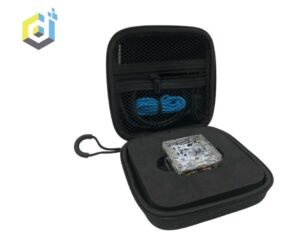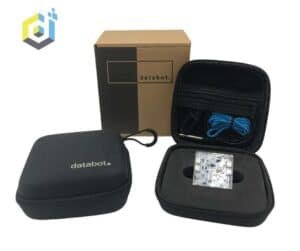Meet MicroBlocks®!!

MicroBlocks is a blocks programming language for physical computing inspired by Scratch. It runs on microcontrollers such as the micro:bit, Calliope mini, AdaFruit Circuit Playground Express, and many others including databot™!
MicroBlocks has some outstanding features for physical computing educators as the code is extremely portable, multi-platform, easy-to-use, and best of all, super fast! Long compile times and download fatigue present significant challenges to educators trying to maintain student engagement. MicroBlocks is a live environment and solves this challenge beautifully. Click on a block and it runs immediately, right on the board. Try out commands. See and graph sensor values in real time. No more waiting for code to compile and download.
In addition to the sheer speed and engagement provided by MicroBlocks a significant advantage over other environments is the remarkable libraries that are available for interoperability between coding languages and devices. Built-in UDP, MQTT, Websockets, and HTTP enable a wide variety of IOT capabilities and device control as well. This blog highlights such an integration with the Sphero RVR.
Rocking and Rolling with Sphero RVR
The original Sphero RVR was released a few years ago and databot™ was able to take advantage of the mobile platform to conduct data collection experiments, hunting for volatile organic compounds or CO2 levels, etc. As a mobility platform the RVR is an awesome tool. Its grippy rubber treads and a low center of gravity make it a fantastic choice for databot, bristling with sensors and computing power, to take command of and go forth for data powered explorations.
Enter MicroBlocks and its amazing libraries and capabilities for facilitating hardware interoperability. We recently began exploring the many ways that MicroBlocks can be used to interact with other programming environments as well as other hardware devices. As good luck would have it, one of the contributors and MicroBlocks ambassadors is a poet technologist by the name of Wenjie Wu. Check out his remarkable essays on MicroBlocks and other topics here. Wenjie built an RVR library for MicroBlocks that enables UART communications between devices which was exactly what databot needed to take control of the RVR. Awesome possum!
Once a custom cable was cobbled together and the RVR library added to MicroBlocks the rest of the story became very easy to write. Check out the setup pictures, MicroBlocks code, and video below. Now that this part is done, we can’t wait to start designing data collection missions using the RVR mobile platform!

databot™ Mounts Up for Mobile Data Collection!
Taking Control of the RVR

Making a custom cable to connect the databot and RVR UART ports.

Plugging it in!

A few lines of MicroBlocks Code!
And behold, control is established!
A wee bit more code and this beast is tamed and ready to ride into all kinds of data powered adventures. Yeah!
What Adventures Lie Ahead?

databot™ is an amazing, tiny, multi-sensor device designed to facilitate exploring data in engaging, exciting new ways that captivate students’ interest and guide them into a natural conversation with the scientific data that surrounds them. Adding mobility to these data powered explorations adds another dimension to the experience whether you are mounting databot on a drone, the RVR, or a LEGO® robot.
Finally, when you combine these physical computing tools with a powerful environment like MicroBlocks the opportunities become nearly infinite. In addition to reading sensors and reacting to the environment, MicroBlocks also has the ability to facilitate IOT projects. Imagine a live data dashboard on the web that is updating values in real time collected by databot as RVR roams autonomously mapping an area. It might be in another room, or maybe in another country. Woo.
About databot™
databot™ learning solutions transform the way K12 students experience data, science, and technology. In the classroom, after-school, and in the home, our mission is to make interacting with and understanding data a beautiful, fun, and ubiquitous experience. One that crosses the traditional boundaries of all learning environments. The world is driven by data and we are driven to teach future generations how to use it for good. We create data powered technology and brilliant learning activities that empower students everywhere to think deeply, explore with passion, and solve our planetary scale challenges.
Contact us to share ideas, comments, and learn more about our products and mission.

databot Rocks! Get Yours Today!
-
databot
databot Single
$189.99 Select options This product has multiple variants. The options may be chosen on the product pageRated 0 out of 5 -
databot
databot – Twin Pack
$375.00 Select options This product has multiple variants. The options may be chosen on the product pageRated 0 out of 5 -
databot
databot – Class Pack
$1,850.00 Select options This product has multiple variants. The options may be chosen on the product pageRated 0 out of 5 -
databot
databot Training Modules
$399.00 – $1,000.00 Select options This product has multiple variants. The options may be chosen on the product pageRated 0 out of 5




